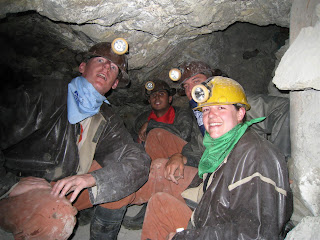Today most of the silver has been plundered and the city is a shadow of its previous grandeur. Tin is now the main extract and most of the mines in the mountain exist on co-op basis. Independent mining teams work various areas and sell whatever ore they find, there is no fixed salary. Sadly, the working conditions have changed very little over the centuries. Miners still use explosive, hammers and buckets on rope. Risk of death is very real, one miner dies a week. Occasionally competition between mining areas develops and lives are lost in underground battles (with dynamite).
A visit to the Potosi mines is a dangerous experience. The mines are not unused, touristy or friendly. Forget any images of long corridors with lifts or even lighting. Many sections are only accessible by crawling. There is no method to extract dangerous gases or provide oxygen to work. Very few miners avail of modern drilling equipment, dynamite does the digging.
We hopped on a bus with 15 others early on the morning of the tour. Our first stop was to get kitted out in attractive overalls, a helmet and neckerchief (to prevent us breathing too much dust - no high tech masks). We met our guides, all former miners they were effectively rescued as 14 year olds from an early death in their 40s (miners generally die within 20 years of entering the mines due to silicosis, a disease of the lungs caused by breathing various poisonous gases).
From there we stopped off at the Miner's Market. A small district filled with shops selling all sorts of mining equipment and coca leaves. To visit the mines we were expected to buy "presents" of explosives, coca and sweets. This keeps the miners friendly and allows you to watch them work.
A 20 minute bus trip and we were at the entrance to the one of the mines. People were already feeling nervous and we were told that it was possible to turn around at any time, a guide would bring you back. Its impossible to express the next 2 hours with words or pictures. 5 of our group turned back in the first 20 minutes. A tame start of mainly ducking and watching out for hanging pipes gradually became more difficult as we began to crawl through sections downwards, level by level. After one hour we had reached the third level (of 8). Our head torches provided the only light in tight, dusty, claustrophobic tunnels. Breathing was extremely difficult. We were instructed to not touch the walls due to the visible layers or sulphur, arsenic and asbestos. Later we all discussed how a continual effort was required to supress panic, caused by the knowledge that should you need to get out suddenly you would be doing a another 1 hour of climbing.
We met one of the miners who spoke to us about his job, how long he had worked there, how many hours a day etc. We were then introduced to his 13 year old son..... As we sat watching them work, there was a stunned silence as everyone tried to absorb the desperate sight of man, working to the his physical limit, probably a few years from death.
A tough, breathless slog back to the top level again we greeted the daylight with smiles and relief and stood around a little dazed and shocked by the experience. We spoke to our guide briefly who described some of the accidents and deaths that occur on a weekly basis (wisely imparting this info AFTER we had escaped safely). Following this we were given an explosives display! Any dynamite we had left over was primed and attached to a 5 minute fuse. In a strange exhibition you could only see in South America we posed with the lit dynamite for photos before our guide ran off down the road to throw it in the ditch for the big BANG!
We stayed one more night in Potosi before leaving for Sucre, slightly changed by our experience, with an appreciation for our own recession-ridden country and its absence of mines.













No comments:
Post a Comment